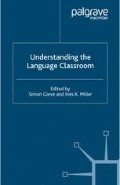Abstract
In his Six Promising Directions in Applied Linguistics, Dick Allwright (2006, Chapter 1 in this volume) makes the case that we have moved from seeing language teaching and learning as a singular, unified undertaking to one that is multi-faceted, messy and even chaotic (the latter are my words, not his.) Allwright describes this shift as a movement from simplicity to complexity, noting that:
Another way of looking at the shift from prescription to description and then to understanding is to think of it more generally as a move from a simplistic way of looking at the world … towards a recognition of the essential and irreducible complexity of the phenomenon of classroom language learning and teaching. (Allwright, 2006)
Access this chapter
Tax calculation will be finalised at checkout
Purchases are for personal use only
Preview
Unable to display preview. Download preview PDF.
References
Allwright, R. 2003. A brief guide to exploratory practice: rethinking practitioner research in language teaching. Language Teaching Research 7, 2:113–42.
Allwright, D. 2006. Six promising directions in Applied Linguistics. In: Understanding the language classroom, eds S. Gieve and I.K. Miller. London: Palgrave Macmillan, Chapter 1 in this volume.
Bailey, K.M., A. Curtis and D. Nunan 2001. Pursuing professional development: the self as source. Boston, MA: Heinle & Heinle.
Calkins, L.M. 1986. The art of teaching writing. Portsmouth, NH: Heinemann.
Chaiklin, S. and J. Lave, eds 1996. Understanding practice: perspectives on activity and context. New York: Cambridge University Press.
Cochran-Smith, M. and S. Lytle 1993. Inside/outside: teacher research and knowledge. New York: Teachers College Press.
Darling-Hammond, L. 1998. Teachers and teaching: testing policy hypotheses from a National Commission Report. Educational Researcher 27, 1:5–15.
Darling-Hammond, L. and G. Sykes, eds 1999. Teaching as the learning profession: handbook of policy and practice. San Francisco: Jossey-Bass.
Engeström, Y., R. Miettinen and R.-L. Punamäki, eds 1999. Perspectives on activity theory. New York: Cambridge University Press.
Freeman, D. 1996. The ‘unstudied problem’: research on teacher learning in language teaching. In: Teacher learning in language teaching, eds D. Freeman and J.C. Richards, 351–77. New York: Cambridge University Press.
Freeman, D. 1998. Doing teacher research: from inquiry to understanding. Boston, MA: Heinle & Heinle.
Freeman, D. 2001. Second language teacher education. In: The Cambridge guide to teaching English to speakers of other languages, eds R. Carter and D. Nunan, 72–9. Cambridge: Cambridge University Press.
Freeman, D. and K.E. Johnson 2004. Towards linking teacher knowledge and student learning. In: Second language teacher education: international perspectives, ed. D. Tedick. Mahwah, NJ: Lawrence Erlbaum.
Freeman, D. and J.C. Richards 1993. Conceptions of teaching and the education of second language teachers. TESOL Quarterly27, 2:193–216.
Haney, W. 1993. Minorities and testing. In: Beyond silenced voices: class, race and gender in United States schools, eds L. Weis and M. Fine, 45–73. Albany, NY: State University of New York Press.
Hawley, W. and L. Valli 1999. The essentials of effective professional development: a new consensus. In: Teaching as the learning profession: handbook of policy and practice, eds L. Darling-Hammond and G. Sykes, 127–50. San Francisco: Jossey-Bass.
Johnson, K.E. 1999. Understanding language teaching: reasoning in action. Boston, MA: Heinle & Heinle.
Kelly, M., M. Grenfell, R. Allan, C. Kriza and W. McEvoy 2004. European profile for language teacher education: a frame of reference. Graz: European Centre of Modern Languages.
Kennedy, M. 1991. An agenda for research on teacher learning. East Lansing, MI: National Center for Research on Teacher Learning.
Lantolf, J., ed. 2000. Socio-cultural theory and second language learning. New York: Oxford University Press.
Larsen-Freeman, D. 1997. Chaos/complexity science and second language acquisition. Applied Linguistics 18, 2:141–65.
Lortie, D. 1975. Schoolteacher: a sociological study. Chicago, IL: University of Chicago Press.
Michaels, S. 1985. Classroom processes and the learning of text-editing commands. Quarterly Newsletter of the Laboratory of Human Cognition 5:30–34.
Ministry of Education and Culture (MEC), Brazil 1996. Development of education in Brazil. Brasilia: NDOE.
National Department of Education (NDOE), Republic of South Africa 1996. An agenda of possibilities: national policy on teacher supply, utilisation, and development. Pretoria: Author.
Nunan, D. and C. Lamb, eds 1995. The self-directed teacher. New York: Cambridge University Press.
Säljö, R. 1997. Learning and socio-cultural change: inaugural lecture for the van Zuylen Visiting Professorship. Faculty of Social Sciences, University of Utrecht.
Sizer, T. 1992. Horace’s school: redesigning the American high school. Boston, MA: Houghton-Mifflin.
Stevick, E. 1980. Teaching languages: a way and ways. Rowley, MA: Newbury House.
Tyack, D. and L. Cuban 1995. Tinkering toward utopia: a century of public school reform. Cambridge, MA: Harvard University Press
Watson-Gegeo, K.A. 2004. Mind, language, and epistemology: toward a language socialization paradigm for SLA. Modern Language Journal 88, 3:331–50.
Wells, G. 1999. Dialogic inquiry: towards a sociocultural practice and theory of education. New York: Cambridge University Press.
Wertsch, J. 1998. Mind as action. New York: Oxford University Press.
Woods, D. 1996. Teacher cognition in language teaching. New York: Cambridge University Press.
Editor information
Editors and Affiliations
Copyright information
© 2006 Donald Freeman
About this chapter
Cite this chapter
Freeman, D. (2006). Teaching and Learning in ‘The Age of Reform’: The Problem of the Verb. In: Gieve, S., Miller, I.K. (eds) Understanding the Language Classroom. Palgrave Macmillan, London. https://doi.org/10.1057/9780230523166_13
Download citation
DOI: https://doi.org/10.1057/9780230523166_13
Publisher Name: Palgrave Macmillan, London
Print ISBN: 978-0-230-20695-3
Online ISBN: 978-0-230-52316-6
eBook Packages: Palgrave Language & Linguistics CollectionEducation (R0)

